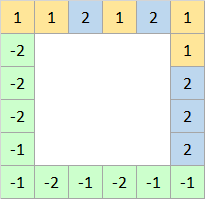Sperner’s Lemma is often called the "combinatorial analog" of Brouwer’s Fixed Point Theorem, and similarly Tucker’s Lemma is often called the combinatorial analog of Borsuk–Ulam’s Theorem.
Even though we can fairly directly show Borsuk–Ulam implies Brouwer, it seems no direct combinatorial proof is known between Tucker's and Sperner's Lemma. (Please see a related discussion from 2013/2014 with links to good articles at Sperner's lemma and Tucker's lemma)
My question: has there been any new development on research for a direct combinatorial link between the two Lemmas?
For background, to explain what is driving this question, I am using a 2-dimensional example. It is an example where Tucker’s Lemma follows directly from Sperner’s Lemma (under suitable "compatibility" conditions on the boundary labelling).
Take a triangulated polygon with vertices labelled -2, -1, 1, or 2, and anti-symmetric labelling on its boundary, such that it satisfies the conditions of Tucker’s Lemma. Assume the boundary labels can be colored in a way that meets the conditions of Sperner’s Lemma. Here is a simple example which shows the Tucker anti-symmetric number labelling and the Sperner color labelling (this example only shows the boundary labelling, the triangulation and the inside vertices are not shown).
Assign the colors to all the number-labelled vertices inside the polygon in the same way (i.e. $1\mapsto \text{orange}$; $2\mapsto \text{blue}$; $-1, -2\mapsto \text{green}$).
Because of the Sperner coloring of the boundary, a 3-colored Sperner triangle must exist. But this 3-colored triangle either has a complementary green–orange edge $(-1,1)$ or a complementary green–blue edge $(-2,2)$. In other words, it follows directly from Sperner’s Lemma that a complementary edge exists, proving Tucker’s Lemma.
So, in cases like this one, Sperner directly implies Tucker without any additional proof steps. I find this an obvious, direct combinatorial link between the two Lemmas, hence my question about any recent results or ideas in this direction.

